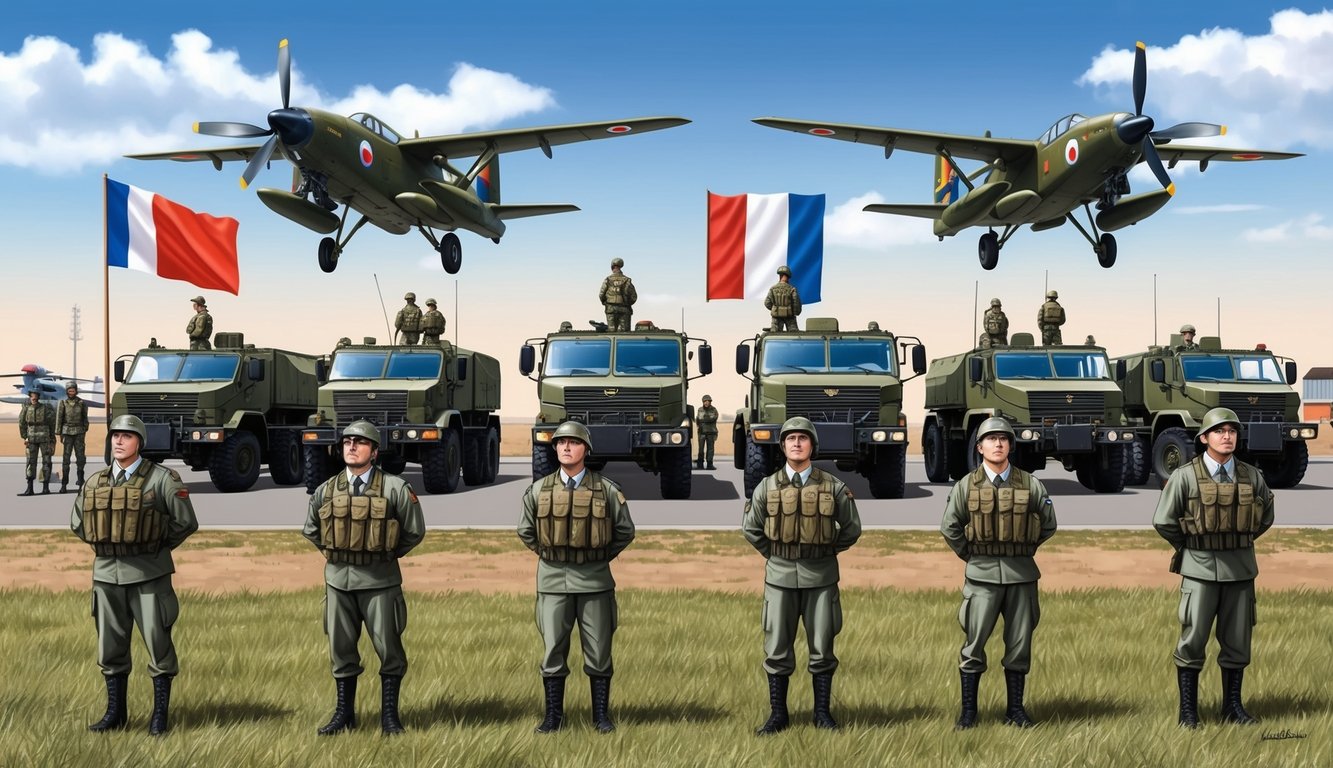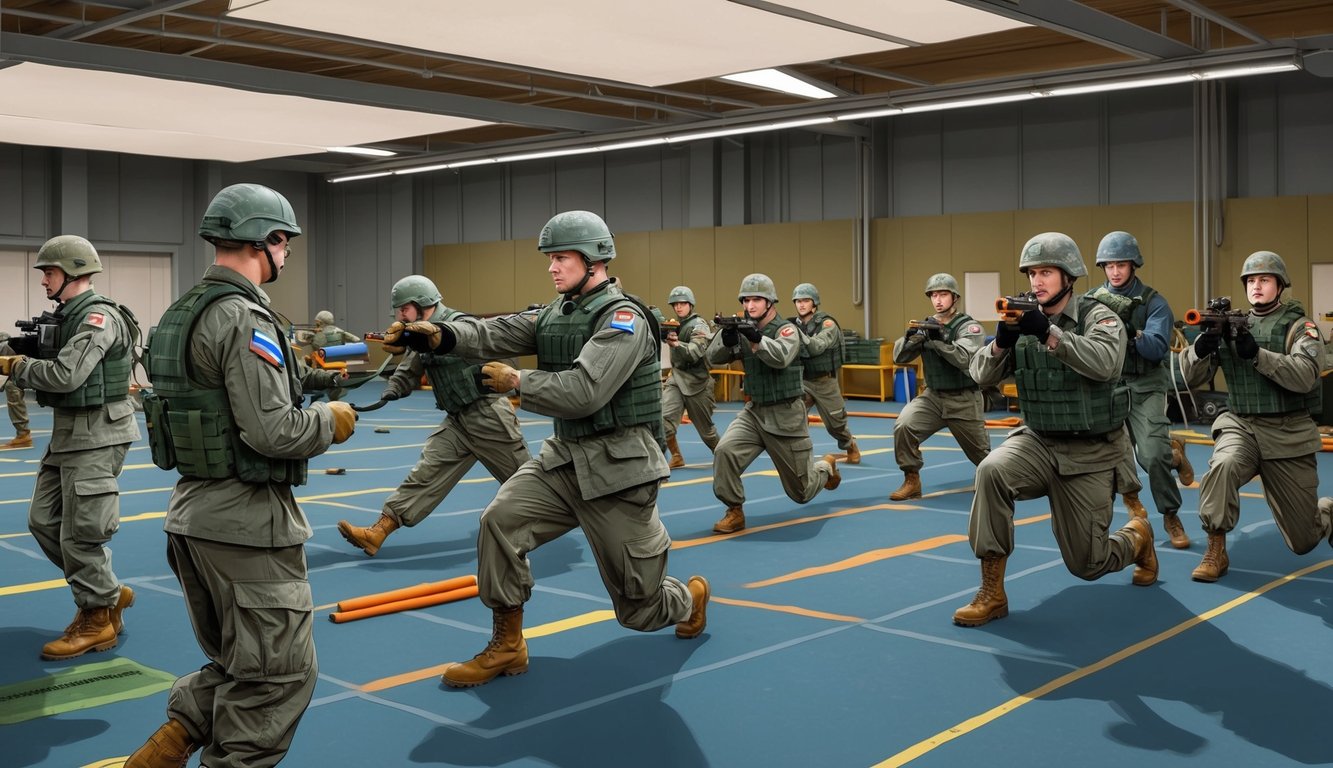The Netherlands, renowned for its enchanting windmills and vibrant tulip fields, also maintains a formidable military presence.
The Royal Netherlands Armed Forces encompass the Army, Navy, Air Force, and Marechaussee (military police), which collaborate to protect Dutch interests both domestically and internationally.
With origins tracing back to 1572, the Dutch military has a storied history of defending the nation’s sovereignty.
Today, it represents a modern force adjusting to contemporary challenges in a constantly evolving global landscape.
The Netherlands is actively enhancing its defense capabilities, acknowledging the importance of preparedness in an unpredictable world.
As a NATO member, the Dutch military is integral to collective defense and international peacekeeping operations.
Interestingly, despite its relatively modest size, the Netherlands excels in military technology and expertise, particularly in fields such as cybersecurity and special operations.
Key Takeaways
- The Dutch military intertwines centuries of tradition with advanced technology to safeguard national interests.
- As a NATO member, the Netherlands plays a vital role in international security initiatives.
- The nation is rigorously modernizing its armed forces to tackle emerging global threats.
Historical Context
The evolution of the Netherlands’ military over the centuries has significantly shaped its defense capabilities and international standing, marked by pivotal changes and adaptations to shifting global dynamics.
Foundation of the Dutch Military
The origins of the Dutch military can be traced back to the 16th century during the Dutch Revolt against Spanish dominance.
The insurrection led to the establishment of the Dutch Empire and a formal military organization in 1568.
Early Dutch forces were especially recognized for their maritime strength.
The Dutch Navy emerged as a potent force, safeguarding trade routes and colonial endeavors.
On land, the Dutch Army developed innovative strategies, implementing smaller, more agile units and advancing firearms technology.
This approach effectively countered larger, less nimble adversaries.
Involvement in Global Conflicts
During the World Wars, the Netherlands encountered major obstacles.
While it maintained neutrality in WWI, WWII proved unavoidable as Nazi Germany invaded in 1940, resulting in a five-year occupation.
The Dutch resistance during this period was notably impressive.
Following WWII, the Netherlands became a founding member of NATO in 1949.
This alliance transformed Dutch military strategy, emphasizing collective defense against Soviet threats.
Dutch forces have engaged in UN peacekeeping missions, reflecting their commitment to global security.
Post-Cold War Developments
In the post-Cold War era, the Dutch military has adapted to new hazards, shifting focus from territorial defense to managing international crises.
Dutch troops have actively participated in missions in Afghanistan, Iraq, and Mali, among others.
The military has modernized its structure and equipment, resulting in a more versatile and rapidly deployable force.
The Netherlands has increased its emphasis on cybersecurity and counterterrorism capabilities.
Current events, such as Russia’s actions in Ukraine, have heightened awareness of European security, leading to deeper Dutch military collaboration within NATO and the EU to confront these challenges.
Structure of the Dutch Armed Forces

The Netherlands Armed Forces comprise four primary branches that cooperate to defend the nation and contribute to international security.
Each branch possesses unique capabilities and assets to fulfill its distinct role.
Royal Netherlands Navy
The Royal Netherlands Navy protects Dutch maritime interests and conducts maritime operations.
Its fleet includes modern frigates, submarines, and patrol vessels for various missions such as anti-submarine warfare, coastal patrols, and support for amphibious operations.
The Navy operates four De Zeven Provinciën-class air defense and command frigates, which are adept at countering air and surface threats.
Additionally, two Walrus-class submarines conduct covert operations and intelligence surveillance.
For coastal operations, the Navy employs Holland-class offshore patrol vessels optimized for maritime security and anti-drug initiatives in the Caribbean.
Royal Netherlands Army
The Royal Netherlands Army oversees land-based military initiatives.
It is equipped with a range of armored vehicles and artillery for both combat and peacekeeping operations.
The tank battalion, featuring German-made Leopard 2A6 tanks, forms the backbone of the Army’s combat power, providing substantial firepower and defense during engagements.
Accompanying the tanks are PzH 2000 self-propelled howitzers, which deliver precise long-range fire support.
The Army also comprises light and medium infantry battalions that are trained for diverse missions, ranging from high-intensity combat to disaster relief efforts.
Royal Netherlands Air Force
The Royal Netherlands Air Force is tasked with defending Dutch airspace and assisting ground operations through aerial support.
Its inventory features a combination of fighter jets, transport aircraft, and helicopters.
A highlight of the Air Force is its fleet of F-35 Lightning II fighter jets, which offer advanced stealth capabilities for superior air combat and ground strike missions.
For logistical operations, C-130 Hercules transport planes are utilized, known for their versatility in delivering troops and supplies to remote locations or aiding in humanitarian missions.
The Air Force also operates CH-47 Chinook helicopters for tactical transport and AH-64 Apache attack helicopters for close air support, providing essential mobility and firepower to ground forces.
Defensive Strategy and Alliances
The military strategy of the Netherlands centers on collective defense achieved through robust international partnerships.
The Dutch armed forces are deeply integrated into NATO and actively participate in various global missions.
NATO Membership and Contributions
As a founding NATO member, the Netherlands plays a key role within the alliance.
Dutch forces consistently contribute to NATO’s deterrence and defense operations.
Dutch F-35 fighters are engaged in air policing operations over Eastern Europe, while naval vessels join NATO maritime task forces in the North Atlantic and Mediterranean.
The Netherlands also hosts vital NATO facilities, including the Joint Force Command in Brunssum, which supervises NATO operations across Northern Europe.
Dutch military planners collaborate closely with their allies to ensure effective integration of forces and resources.
International Missions and Operations
Beyond NATO obligations, Dutch troops engage in various international missions.
The Netherlands Armed Forces partake in UN peacekeeping endeavors, EU training missions, and collaborative anti-terrorism efforts.
You might find Dutch special forces deployed in the Sahel region of Africa to combat extremist factions.
Dutch naval vessels frequently participate in anti-piracy operations off the Horn of Africa, while the Military Police (Marechaussee) lend their expertise to international missions in law enforcement and border security.
These global deployments provide Dutch forces with valuable experience while furthering international security goals.
Modernization and Capabilities
The Netherlands is diligently upgrading its military capabilities to address current security challenges.
Significant investments are being made in new equipment, while also focusing on bridging capability gaps within the armed forces.
Asset Acquisition and Maintenance
Substantial enhancements are being seen in the Dutch military’s hardware.
The Netherlands is procuring new helicopters to boost mobility and combat support, alongside modernizing weapon systems to enhance firepower and accuracy.
Maintaining existing equipment is equally a priority, with efforts underway to prolong the lifespan of Leopard 2 tanks to maintain armored strength.
The defense budget has experienced considerable growth, reaching €21.4 billion in 2024, representing approximately 1.95% of GDP.
This increase facilitates more ambitious modernization objectives.
Capability Shortfalls and Modernization Efforts
Interestingly, some gaps have been identified within the Dutch military.
NATO’s review in 2021-22 pointed out a shortage of heavy and medium infantry brigades.
In response, initiatives are being undertaken to strengthen mechanized units and firepower.
There are ongoing enhancements to tank capabilities and infantry fighting vehicles.
Air defense remains a critical focus, prompting plans for new investments in anti-aircraft systems to counter emerging aerial threats.
The Defense Vision 2035 lays out aims for a high-tech, flexible military, emphasizing smart technologies and network-centric warfare capacities.
Personnel and Training

The Netherlands adopts a distinctive approach to military staffing and readiness.
This includes a blend of voluntary service and specialized training programs that shape the defense forces.
Military Age and Conscription Policies
Although conscription exists in the Netherlands, it is currently on hold.
Individuals may enlist voluntarily at age 17, with active duty commencing at 18.
The military primarily consists of a small professional force, rather than a conscripted army.
Reserve troops play an essential role, supplementing active-duty forces as required.
This system provides the military with flexibility while keeping expenses manageable.
Recruiting and Training Defense Personnel
For those eager to join the Dutch military, a variety of opportunities are available.
The Royal Netherlands Army provides extensive training programs, ranging from basic military preparation to specialized training courses.
Officers are educated at the Netherlands Defence Academy, with initial officer training available at the Royal Military Academy in Breda or the Royal Naval College in Den Helder.
High-tech simulation systems enhance training effectiveness, equipping personnel for a broad range of real-world scenarios.
The military also emphasizes skills development for humanitarian assistance and disaster relief, ensuring that recruits can support civilian populations during crises.
Challenges and Opportunities

The Dutch military faces intricate challenges in an ever-changing security environment, balancing resource allocation with international obligations reveals both obstacles and opportunities for advancement.
Demands in a Changing Security Environment
As the security landscape shifts, the Netherlands encounters numerous challenges.
The defense budget must evolve to address new threats, resulting in enhanced attention on cybersecurity and hybrid warfare.
The Middle East continues to be a focal area of concern, where the Dutch military is actively engaged in stability operations.
Maintaining the International Legal Order is a priority, as the Netherlands values global collaboration and respect for the rule of law.
NATO commitments dictate military priorities, necessitating that the Netherlands meet alliance objectives and engage in joint exercises.
Additionally, climate change poses emerging security challenges, leading to military adaptations to address environmental disasters and Arctic issues.
Frequently Asked Questions

The Dutch military presents a range of opportunities along with specific service requirements.
This includes enlistment options, recruitment standards, compensation, rank structure, capabilities, and uniforms.
How can foreigners enlist in the Dutch military?
Foreign nationals can join the Dutch military under certain conditions.
Candidates must be citizens of an EU/EEA country or Switzerland, possess fluent Dutch language skills, and pass language assessments.
Permanent residency in the Netherlands is essential, along with meeting physical and educational prerequisites.
Some specialist roles may require additional qualifications.
What are the current recruitment requirements for the Netherlands Army?
To enlist in the Netherlands Army, individuals must be at least 17 years old and have at least a high school diploma or equivalent.
Physical fitness evaluations are compulsory.
Having a clean criminal record is crucial, and candidates will undergo medical and psychological assessments.
Most positions require Dutch citizenship, with some exceptions for EU citizens.
What salary can one expect from a career in the Netherlands military?
Military salaries in the Netherlands vary based on rank and experience.
New recruits can expect starting salaries around €1,500 to €2,000 per month.
Officers and specialists earn higher salaries, and promotions accompanied by years of service can lead to significant salary increases.
Additional benefits may include housing assistance and healthcare services.
How does the Netherlands’ military rank structure look as of 2024?
The Dutch military employs a hierarchical rank structure akin to those of other NATO nations.
Enlisted ranks begin with Soldaat (Private) and progress to Adjudant-onderofficier (Warrant Officer).
Officer ranks start with Luitenant (Lieutenant) and can ascend to Generaal (General) or Admiraal (Admiral).
Each military branch may have slight variations in rank titles.
What are the key components of the Netherlands military strength?
The Netherlands military comprises the Army, Navy, Air Force, and Marechaussee (Military Police).
Key strengths include advanced naval forces and specialized units.
The Air Force operates F-35 fighter jets and transport aircraft, while the Army features mechanized infantry and armored divisions.
Cyber defense and peacekeeping missions are critical areas of focus as well.
Can you describe the standard uniform of the Netherlands Army?
The standard combat uniform of the Netherlands Army showcases a digital camouflage pattern in shades of green, brown, and black, designed for effectiveness across diverse environments.
The uniform includes a combat shirt, trousers, and boots.
For formal events, a dress uniform is worn, characterized by dark blue fabric adorned with gold accents.
Different colored berets signify various military units.

